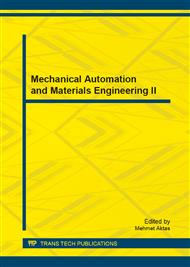[1]
X Xu, S Hinduja. Recognition of rough machining features in 2. 5D components[J]. Computer- Aided Design, 1998, 30(7): 503~516.
DOI: 10.1016/s0010-4485(97)00090-0
Google Scholar
[2]
Nandakumar Sridharan, Jami J. Shah. Recognition of Multi-Axis Milling Features: Part I- Topological and Geometric Characteristics[J]. Journal of Computing and Information Science in Engineering, 2004, 4(3): 242~250.
DOI: 10.1115/1.1778718
Google Scholar
[3]
C. Grabowik, K. Kalinowski, Z. Monica. Intergration of the CAD/CAPP/PPC systems[J]. Journal of Materials Processing Technology, 2005, 164-165: 1358~1356.
DOI: 10.1016/j.jmatprotec.2005.02.036
Google Scholar
[4]
Woo T C. Feature Extraction by Volume Decomposition[M]/CAD/CAM Technology in Mechanical Engineering. 1982:97~109.
Google Scholar
[5]
Martín G. Marchetta, Raymundo Q. Forradellas. An artificial intelligence planning approach to manufacturing feature recognition[J]. Computer-Aided Design, 2010, 42(5): 248~256.
DOI: 10.1016/j.cad.2009.11.007
Google Scholar
[6]
Saleh M. Amaitik, S. Engin Kilic. An intelligent process planning system for prismatic parts using STEP features[J]. International Journal of Advanced Manufacturing Technology, 2007, 31: 978~993.
DOI: 10.1007/s00170-005-0269-5
Google Scholar
[7]
Zhenkai Liu, Lihui Wang. Sequencing of interacting prismatic machining features for process planning [J]. Computer In Industry, 2007, 58(4): 295~303.
DOI: 10.1016/j.compind.2006.07.003
Google Scholar
[8]
Honglee. Rule-Based Process Planning By Grouping Features[J]. KSME International Journal, 2004, 18(12): 2095~2103.
DOI: 10.1007/bf02990214
Google Scholar
[9]
Yoonhwan Woo, Sakurai H. Recognition of maximal features by volume decomposition[J]. Computer Aided Design, 2002, 34(3): 195~207.
DOI: 10.1016/s0010-4485(01)00080-x
Google Scholar


